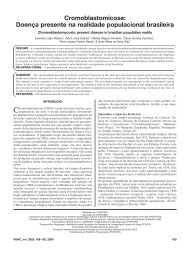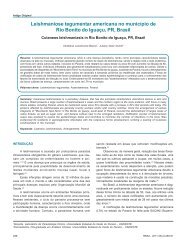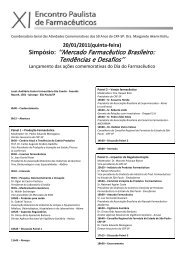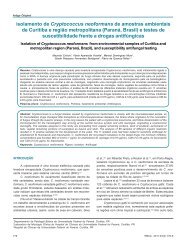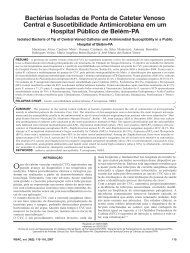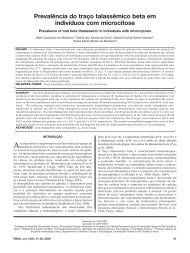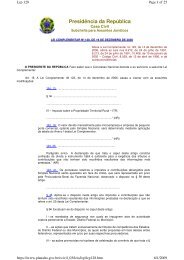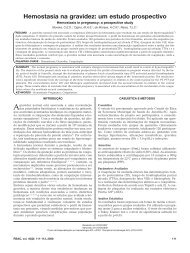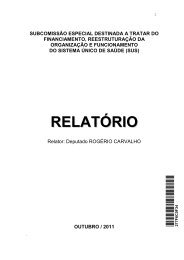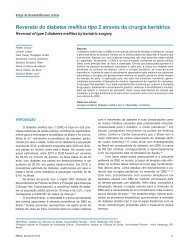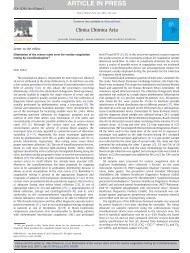Suitability of a transport box for blood sample shipment over a long ...
Suitability of a transport box for blood sample shipment over a long ...
Suitability of a transport box for blood sample shipment over a long ...
Create successful ePaper yourself
Turn your PDF publications into a flip-book with our unique Google optimized e-Paper software.
G. Lippi et al. / Clinical Biochemistry 44 (2011) 1028–1029<br />
1029<br />
Fig. 1. Fluctuation <strong>of</strong> the inner temperature <strong>of</strong> a <strong>transport</strong>ation <strong>box</strong> during the 8-h study period.<br />
closure <strong>of</strong> the <strong>box</strong>, so that <strong>transport</strong>ation from the private facility to the<br />
core laboratory by courier as per manufacturer requirements started at<br />
this time point. After 7 h and 30 min <strong>of</strong> <strong>transport</strong>ation the <strong>box</strong> arrived<br />
at the destination, in the core laboratory. Temperature data were<br />
further analyzed with LogTag Analyser®. The limit <strong>of</strong> suitable<br />
temperature fluctuation was established between 2 °C and 8 °C (i.e.,<br />
35.6 °F—46.4°F), in agreement with the current recommendations <strong>of</strong> the<br />
Clinical and Laboratory Standard Institute (CLSI) [8]. The environmental<br />
temperature during <strong>transport</strong>ation was comprised between 36 °C and<br />
38 °C, whereas that <strong>of</strong> the private facility and the core laboratory was<br />
~20 °C.<br />
Results<br />
The fluctuation <strong>of</strong> the temperature within the <strong>transport</strong> <strong>box</strong> during<br />
the 8-h study period is shown in Fig. 1. Thirty minutes after the closure<br />
<strong>of</strong> the <strong>box</strong> at the private facility the temperature rapidly fell from room<br />
temperature (i.e., ~20 °C) to 6 °C, in agreement with manufacturer's<br />
claim. After beginning <strong>of</strong> <strong>transport</strong>ation, a nearly linear increase <strong>of</strong><br />
temperature was then observed, exceeding the upper suitable limit (i.e.,<br />
8 °C) after 120 min (i.e., 90 min from the beginning <strong>of</strong> <strong>transport</strong>ation).<br />
Twenty min after arrival at the core laboratory, the internal temperature<br />
<strong>of</strong> the <strong>transport</strong> <strong>box</strong> dropped down at 7 °C. As such, temperature<br />
stability could be considered unsatisfactory during approximately 64%<br />
<strong>of</strong> the <strong>transport</strong>ation time, i.e., from 125 to 450 min.<br />
Discussion<br />
The increasing centralization <strong>of</strong> laboratory facilities has raised<br />
important economical, organizational and preanalytical issues such as<br />
the escalation <strong>of</strong> costs, the <strong>long</strong>er <strong>transport</strong>ation times and the<br />
potential increase <strong>of</strong> preanalytical errors due to the <strong>of</strong>ten challenging<br />
conditions <strong>of</strong> <strong>transport</strong>ation and storage <strong>of</strong> the specimens [5,6].<br />
Establishment and maintenance <strong>of</strong> appropriate temperatures <strong>for</strong><br />
<strong>transport</strong>ation is essential <strong>for</strong> preserving the quality <strong>of</strong> whole <strong>blood</strong><br />
and even centrifuged specimens, thus preventing irreversible physicochemical<br />
alterations <strong>of</strong> <strong>blood</strong> components. According to the current<br />
recommendations <strong>of</strong> the CLSI, chilled <strong>blood</strong> specimens should be<br />
maintained at temperatures comprised between 2 °C and 8 °C until<br />
separation [8]. As such, the <strong>transport</strong>ation <strong>of</strong> <strong>sample</strong>s and <strong>blood</strong><br />
components is increasingly accomplished by safety <strong>transport</strong> <strong>box</strong>es,<br />
especially in countries with high or even extreme environmental<br />
temperatures and where <strong>shipment</strong> might occur <strong>over</strong> <strong>long</strong> distances.<br />
Nevertheless, no published data are available to the best <strong>of</strong> our<br />
knowledge on the per<strong>for</strong>mance <strong>of</strong> <strong>transport</strong>ation <strong>box</strong>es as regards<br />
temperature stability throughout <strong>long</strong> periods <strong>of</strong> <strong>transport</strong>ation, up to<br />
several hours. Although limited to the evaluation <strong>of</strong> a single<br />
commercial product the results <strong>of</strong> this investigation attest that the<br />
recommended temperature <strong>for</strong> <strong>transport</strong>ation (i.e., between 2 °C and<br />
8 °C) might only be maintained <strong>for</strong> a limited period <strong>of</strong> time within a<br />
<strong>transport</strong> <strong>box</strong> (e.g., up to 90 min), because the internal temperature<br />
might be dramatically influenced by the environmental conditions. As<br />
such, we hypothesized that some <strong>of</strong> these products might be<br />
unsuitable to fulfil the requirements <strong>of</strong> some peripheral facilities<br />
integrated within a network, especially those which ship the<br />
specimens to very distant core laboratories. Rather understandably,<br />
although all the experimental conditions were accurately standardized,<br />
replication <strong>of</strong> this study at different temperature (e.g., high or<br />
even extreme external temperatures) or humidity, as well as the use<br />
<strong>of</strong> different types <strong>of</strong> containers made on different materials, might<br />
provide different outcomes, so that additional studies should be<br />
planned to test this hypothesis.<br />
References<br />
[1] Plebani M, Lippi G. To err is human. To misdiagnose might be deadly. Clin Biochem<br />
2010;43:1–3.<br />
[2] Lippi G, Guidi GC, Mattiuzzi C, Plebani M. Preanalytical variability: the dark side <strong>of</strong><br />
the moon in laboratory testing. Clin Chem Lab Med 2006;44:358–65.<br />
[3] Lippi G. G<strong>over</strong>nance <strong>of</strong> preanalytical variability: travelling the right path to the<br />
bright side <strong>of</strong> the moon? Clin Chim Acta 2009;404:32–6.<br />
[4] Lima-Oliveira G, Picheth G, Sumita NM, Scartezini M. Quality control in the<br />
collection <strong>of</strong> diagnostic <strong>blood</strong> specimens: illuminating a dark phase <strong>of</strong> preanalytical<br />
errors. J Bras Patol Med Lab 2009;45:441–7.<br />
[5] Plebani M, Lippi G. Is laboratory medicine a dying pr<strong>of</strong>ession? Blessed are those<br />
who have not seen and yet have believed. Clin Biochem 2010;43:939–41.<br />
[6] Plebani M, Lippi G. Focused factories and boutique laboratories. The truth might lie<br />
in between. Clin Biochem 2010;43:1484–5.<br />
[7] Klose T, Borchert HH, Pruss A, Roth WK, Bohnen HR, Putzker M. Current concepts<br />
<strong>for</strong> uality assured <strong>long</strong>-distance <strong>transport</strong> <strong>of</strong> temperature-sensitive red <strong>blood</strong> cell<br />
concentrates. Vox Sang 2010;99:44–53.<br />
[8] Clinical and Laboratory Standard Institute. Procedures <strong>for</strong> the Handling and<br />
Processing <strong>of</strong> Blood Specimens; Approved Guideline—Fourth Edition. CLSI document<br />
H18-A3940 West Valley Road, Suite 1400, Wayne, Pennsylvania 19087 1898<br />
USA: Clinical and Laboratory Standards Institute1-56238-724-3; 2010.



